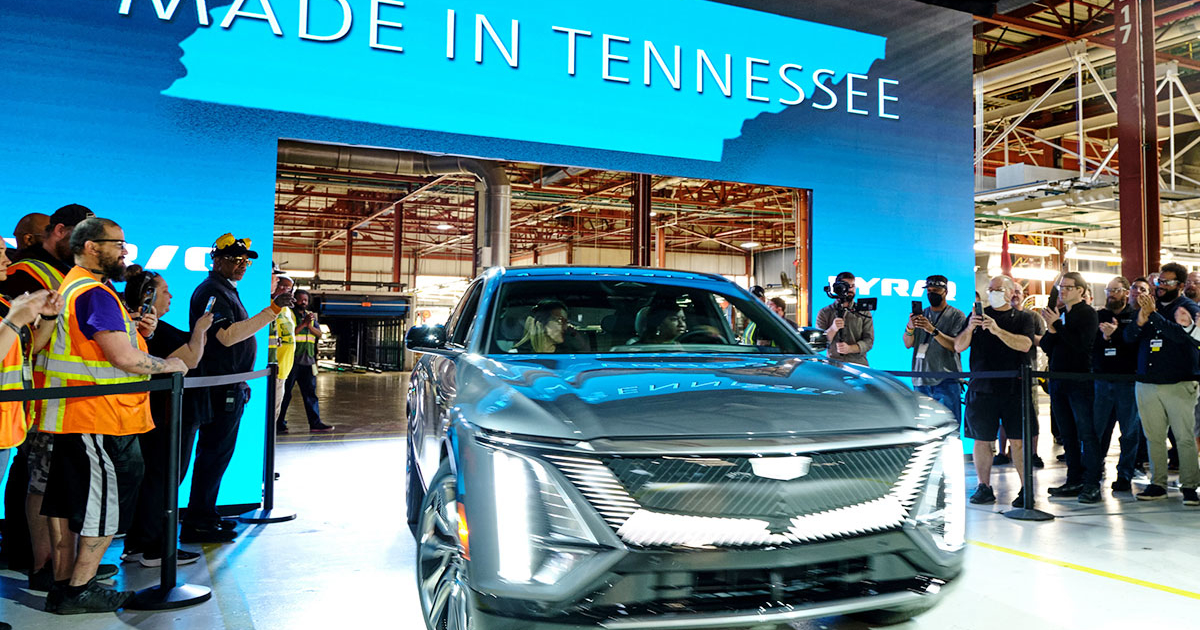
General Motors’ promise to build an electric vehicle for every buyer will begin to materialize in 2023.
By the end of next year, GM plans to have launched at least three mass-market EVs powered by its Ultium batteries. By 2026, the automaker could have close to a dozen mainstream electric options. A year later, GM expects to begin working with Honda Motor Co. to produce millions of affordable EVs.
At the moment though, GM’s mass-market EV entries, underpinned by its proprietary Ultium batteries, lag competitors such as Ford Motor Co., which launched the F-150 Lightning electric pickup this year.
GM opted to start its Ultium-powered EV rollout with high-performance, luxury models: the GMC Hummer EV pickup and the Cadillac Lyriq crossover.
The early EV launches are meant to show the automakers’ EV prowess — through the Hummer pickup’s 1,000 hp and 329 miles of range, for example — and prove that the Ultium platform can go beyond the more utilitarian design of its Chevrolet Bolt.
Two more high-end EVs are due next year: the ultraluxury, hand-built Cadillac Celestiq sedan and the Hummer SUV.
But 2023 also marks the arrival of GM’s volume EVs: the Chevy Silverado and GMC Sierra pickups and the Chevy Blazer and Equinox crossovers. The Equinox EV is expected to retail for about $30,000, and the Blazer, unveiled last week, starts at less than $50,000. GM also plans to slash the starting prices of the 2023 Bolt EV and EUV, which use its previous-generation batteries, to less than $30,000.
“It’s going to be the next wave that will crack the market for GM,” said Sam Fiorani, vice president of global vehicle forecasting at AutoForecast Solutions. “Starting in 2024, once GM has a range of lower-price and higher-volume models on the market, then we can start to see GM actually attacking this segment. It will take models like the Silverado, which is key to the growth of EVs for GM, and the lower-price Equinox EV to hit entry-level EV buyers.”
Except for full-size pickups and SUVs, GM’s portfolio could be all-electric by the early 2030s, according to production forecasts. The company has said it aims to remove internal combustion engines from its light-duty lineup by 2035.
GM’s manufacturing footprint soon will match its EV ambitions. By the end of 2026, half of GM’s North American plants are expected to build EVs. At least two of those — Arlington Assembly in Texas and Wentzville Assembly in Missouri — will continue to produce gasoline-powered vehicles as well.
Eight plants will remain internal combustion-only through at least 2026. Most build high-demand nameplates that GM will continue selling until it’s ready to fully transition to EVs. They include GM’s pickup plants in Michigan, Indiana, Ontario and Mexico and the Chevy Corvette plant in Kentucky. San Luis Potosi Assembly in Mexico is expected to build the gasoline-powered Chevy Equinox and GMC Terrain beyond 2026. One plant — Fairfax Assembly in Kansas, which makes the Cadillac XT4 and Chevy Malibu that are expected to be discontinued — has an unclear future.
GM’s six other North America assembly plants will be EV-only, with vehicles divided among them by segment.
“They seem to be organizing by basic size of the battery pack,” Fiorani said. “When you have the larger trucks being built in Michigan and smaller crossovers being built in Mexico, you’re combining the same type of platform and similar size of battery pack. It should make for a more efficient build process.”
Buick and Cadillac are making the fastest move to EVs, with goals of going fully electric by 2030. But they have big changes planned well before that, with Buick not planning to introduce any new combustion-engine vehicles after 2024 and Cadillac intending to discontinue all gasoline-powered vehicles except the Escalade by 2026.
Chevy and GMC also will ramp up EV production over the next five years, but they’ll continue to lean heavily on the tried-and-true combustion models that have positioned GM as a U.S. sales leader for decades.
In Chevy’s case, as a mainstream brand with nearly 3,000 dealerships and about 1.5 million vehicle sales last year, “our philosophy is always to be ready to go at the pace at which the market goes,” said Chevy marketing chief Steve Majoros. “We have to invest in both, and we are investing very aggressively in both.”
Chevy already has eliminated most cars from its lineup, including the Cruze and Sonic, and the Malibu and Camaro could be the next to go, according to forecasters.
“It was hard to make moves like Cruze, like Sonic,” Majoros said, “but we’re going all-in on the segments that matter.”
As Chevy executives visit dealers during a series of regional events this summer, Scott Bell, who became vice president of global Chevy in April, wants to show dealers that the EV investment is real but incremental.
Dealers “have this sense that, ‘You’re taking something away to give me EVs,’ ” Bell said. “But the reality is we’re giving you EVs on top of the great variants in the ICE world.”